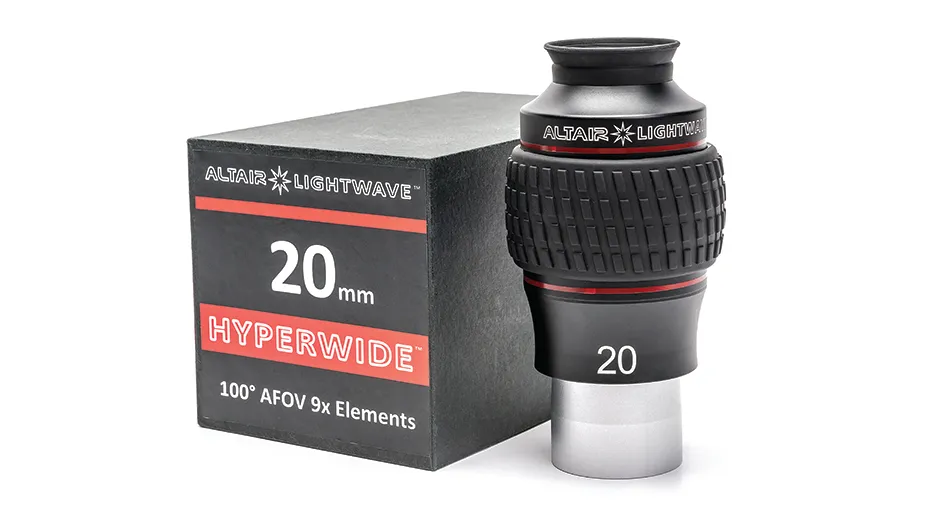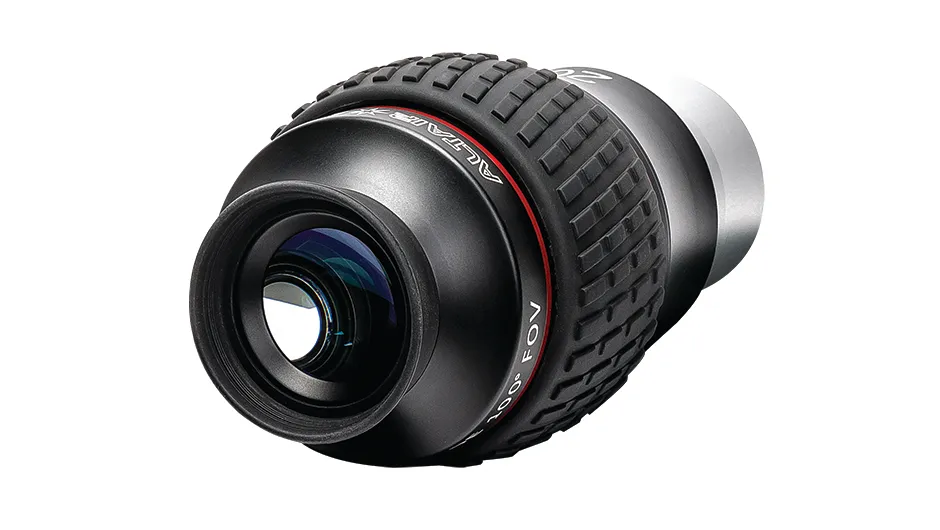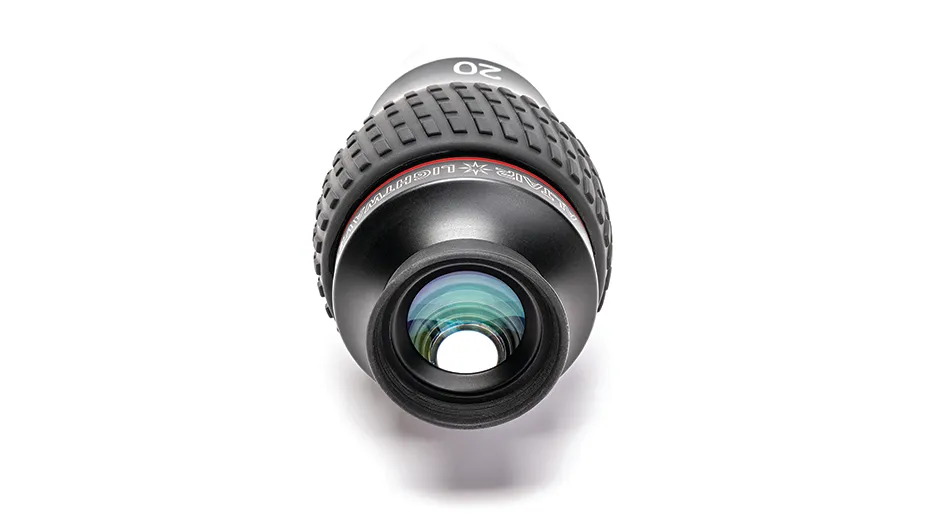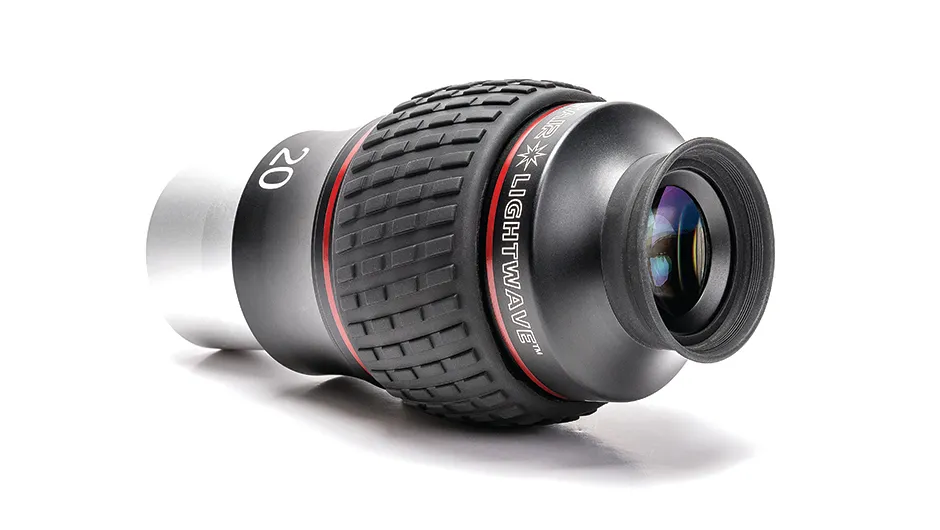Price: £339.00
Focal Length: 20mm
Weight: 879g
Supplier: Altair Astro
Telephone: 01263 731505
Website: www.altairastro.com
For many years, the Plössl eyepiece has been the one most commonly shipped with telescope packages.
Eyepieces of this type typically offer a 50-52° apparent field of view, but more recently those offering wider views have become more popular.
The substantially built Altair Lightwave 20mm Hyperwide 100º eyepiece is the latest to follow this design philosophy.
A large apparent field of view is appealing because it allows the same large expanse of sky visible through a low-power eyepiece to be seen through one with much higher magnification.
The primary function of any eyepiece is to magnify the image produced by a telescope’s optics, thus enabling you to observe celestial objects in all their splendour.

There are various attributes that must be borne in mind in the design of an eyepiece, but the magnification obtained with a given telescope is the one that astronomers often consider first.
The magnification of a given telescope and eyepiece combination is simply calculated by dividing the focal length of the telescope by the focal length of the eyepiece.
Thus, shorter focal length eyepieces result in higher magnification.
With common eyepiece focal lengths ranging from 5mm to 28mm, the 20mm Hyperwide delivers views at the low magnification end of the scale.
Lower magnifications result in wider true fields of view with a given telescope, making these eyepieces most suitable for large objects such as nebulae.
Higher magnifications deliver narrower true fields of view and are at their best observing smaller objects such as planets or fine detail on the surface of the Moon.
Ideals and practicalities
The ideal eyepiece be should unobtrusive in use, so that you can concentrate on the view unencumbered by distractions such as the circular black edge of the field of view.

The Hyperwide certainly removed this diversion with its wide apparent field.
Another attribute that should be considered when selecting an eyepiece is the eye relief, the distance between the outermost lens surface and the position your eye needs to be for the best view.
The eye relief of an eyepiece is independent of the telescope it is used with.
A distance of 15-20mm is ideal, with a greater distance making it easier to use if you wear glasses.
The Hyperwide has an eye relief of 14.5mm, making it a little tight for such stargazers, but fine for everyone else.
We tested the eyepiece on all sorts of celestial objects, starting with the Andromeda Galaxy, M31, which looked spectacular through our 4-inch apo refractor.
With the summer Milky Way cartwheeling into view, we meandered our way towards it – taking in globular clusters M3, M13 and M92 en route, all of which stood out crisply.

Visiting the bright star Vega in Lyra showed that there was a small amount of astigmatism present, and a small ghost reflection was just visible when the star was moved off-axis.
Generally, star shapes were good out to about 85 per cent of the field of view.
The easy to miss Ring Nebula, M57, was very simple to locate given the contrast of the view, though through this eyepiece it was very small indeed.
Continuing our exploration we moved into Cygnus, where we examined the beautiful binary star Albireo and were impressed by the strong colours visible.
We tested for colour aberrations by observing the Moon at first quarter, and were rewarded with an excellent view that was free of colour fringing.
The ability to see good lunar detail yet still view the whole Moon in its natural surroundings produced a real ‘wow’ moment.
We really enjoyed our observing time with the Hyperwide eyepiece and would recommend it to deep-sky observers looking for a more immersive view than normal.

A more natural observing experience
The apparent field of view of an eyepiece describes the total angle of movement that your eye makes when traversing from one edge of the field to the other.
The average adult has a maximum peripheral field of view of around 170° including actual eye movement, which is why it is possible to see the sharply defined edges of the field through an eyepiece, leading to the impression of observing through a porthole or tube.
Increasing the apparent field of view diminishes this effect, producing a more natural and immersive observing experience that, taken to extreme, can make you feel as though you are floating in space.
The complex design of the Hyperwide eyepece comprises nine multicoated and edge-blackened glass elements, resulting in an apparent field of view of 100°, which even by modern standards is pretty wide.
This makes for pleasant and relaxed observing, with your eye able to cover a larger expanse of magnified sky in comparison with a conventional eyepiece design.
2-inch filter thread
Many objects can be seen much better with the use of external filters, such as ultra-high contrast or narrowband OIII.
Usefully, the Hyperwide’s barrel is threaded to take the larger 2-inch filters that are readily available, ensuring that the extra wide field of view is not compromised.
Tapered 2-inch barrel
Dropping such a substantial eyepiece would be an absolute disaster, so making sure it doesn’t slip out of its eyepiece holder is of paramount importance.
This need is met by the 2-inch barrel, which has a tapered section close to the main body – adding a second line of defence should the retaining bolt become loose.

Fold-up rubber eye cup
To obtain the best views from any eyepiece, stray light needs to be kept at bay.
The fold-up rubber eye cup does an excellent job of surrounding your eye with a soft protective screen, but also provides a comfortable resting point for positioning your eye accurately over the exit pupil.
Edge-blackened lenses
Another of the various measures that improve the view through any eyepiece is increasing the contrast by preventing reflections.
The blackened edges of the lens elements, together with high-quality anti-reflection coatings, do this very well indeed.
Rubber grip
Handling any eyepiece outside in the dark (not to mention cold) requires great care.
The Hyperwide has a very chunky 44mm-wide rubber grip, reminiscent of an off-road tyre, surrounding the widest part of the body.
This review originally appeared in the August 2014 issue of BBC Sky at Night Magazine
